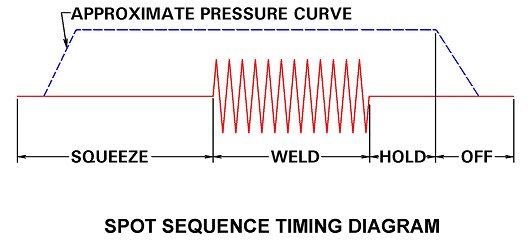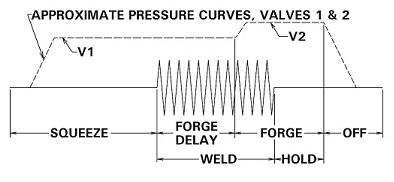Pressure, current and time (PCT) are the basic functions performed by the resistance welder. These functions are controlled or initiated by the weld controller. It initiates each step when told to start the weld process by input from the foot switch or automation PLC. The controller allows time for each step to operate and controls the current amplitude. In simplified form this is Squeeze, Weld and Hold. The squeeze sequence allows the pressure system to build up the force to contain the weld. The weld function is the actual current flow and is totally controlled by the weld controller. It regulates the amplitude and time of current flow. Hold is the period which allows the weld nugget to cool down and solidify under force. The controller regulates this time.


In AC welding the time is measured in cycles. Mid frequency (MFDC) equipment measures time in milliseconds. This time measurement applies to the squeeze, weld and hold functions. The current segment is measured as % heat on many AC devices but many newer devices measure current in amperes. MFDC controllers measure in amperes.
The controller does not regulate the force on most systems. It initiates the signal to a valve or solenoid which starts the application of force by a cylinder or servo. In some cases the controller gets feedback that the force has reached a predefined value before it allows the weld current to initiate.
The hold function is to ensure that the weld nugget solidifies under force. If the force is removed too soon voids and cracks or no weld will result. In some cases extra force is applied to forge the part during the hold function to strengthen the weld joint. A forge diagram is shown above.
There are many options to PCT. The weld control is capable of preheat, postheat, tempering, forging, pulsing, repeat and many other functions, monitoring, data storage and feedback capabilities.
References:
RWMA Resisstance Welding Manual 4th Edition

